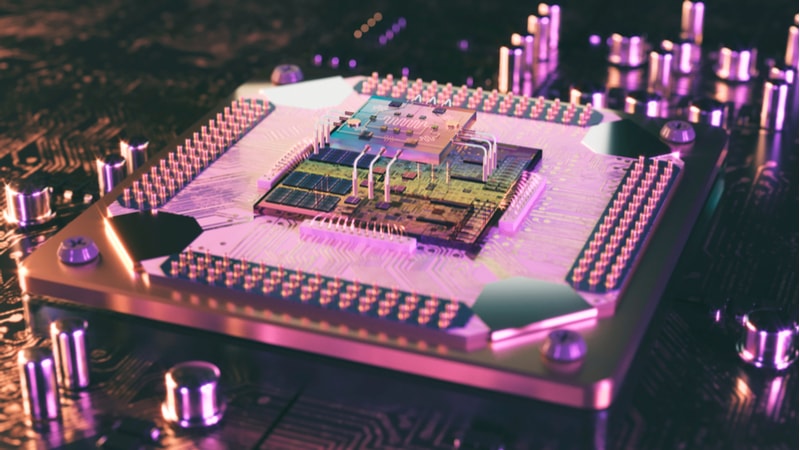How Next-Gen Computers Will Transform What’s Possible for Federal Government

The Accenture Federal Technology Vision highlights four technology trends that will have significant impact on how government operates in the near future. Today we look at Trend #4, Computing the Impossible: New Machines, New Possibilities.
When Intel launched the Intel® 4004 processor in 1971, the first general-purpose programmable processor was the size of a small fingernail and held 2,300 transistors. Today, state-of-the-art microprocessors pack in 60 billion – even 80 billion – transistors.
For federal agencies, the trend towards ever-more-powerful computers has driven significant new efficiencies and discoveries. Yet, we are now approaching the physical and engineering limits of Moore’s Law, the guiding framework for computing advancements over the past five decades. In its place, new computing approaches are emerging, fueling a range of new federal use cases.
Quantum computers, high-performance computers (HPC), and even bio-inspired computing all promise to accelerate innovation and expand upon existing capabilities in the federal space.
Federal leaders are bracing for impact. In a survey by Accenture, ninety-seven percent of U.S. federal executives say their organization is pivoting in response to the unprecedented computational power that is becoming available. The same percentage report that their organization’s long-term success will depend on leveraging next-generation computing to solve the seemingly unsolvable problems.
With ever-more-powerful machines coming to the fore, agencies need to start thinking now about how to make best use of these emerging capabilities in order to take full advantage of the opportunities they present.
What’s Coming
Among next-generation computing types, quantum is currently receiving the most attention because it promises to be so disruptive and transformative. Quantum computers use “qubits,” which can be both 1 and 0 simultaneously, rather than being restricted to one or the other. This quality of qubits enables quantum computers to run more complicated algorithms, tackle millions of computations simultaneously, and operate far faster than traditional computers.
Quantum machines are well-suited for solving optimization problems incorporating large numbers of factors and criteria, giving greater visibility to the entire landscape of possible solutions to decision-makers. The most immediate use cases for this type of capability includes greater efficiencies in scheduling or supply chains, as well as support for the financial services or manufacturing industries.
Then there’s HPC, or massive parallel processing supercomputers. The most mature of the next-gen computers, HPCs help organizations leverage large volumes of data that may be too expensive, time-consuming, or impractical for traditional computers to handle.
HPCs typically rely on different hardware and system designs – where multiple computing processors, each tackling different parts of a problem, are connected together to operate simultaneously. This enables them to solve more complex problems that involve large amounts of data.
HPC is already having an impact for federal agencies. The Energy Department’s National Renewable Energy Laboratory is developing its Kestrel supercomputer to answer key questions needed to advance the adoption of cleaner energy sources. And three federal departments – Health and Human Services, Veterans Affairs, and Energy – have jointly leveraged HPC to accelerate COVID-19 research.
Waiting in the wings is “biocomputing,” which relies on natural biological processes to store data, solve problems, or model complex systems in fundamentally different ways. It could have implications especially for data storage: One estimate predicts DNA could store an exabyte of data in just one cubic centimeter of space, with great reliability.
A related capability, “bio-inspired computing” draws inspiration from biological processes to address challenges in areas such as chip architectures and learning algorithms. Pilots have shown this emergent field can deliver benefits like greater power efficiency, speed, and accuracy in solving more complex problems.
These examples help to demonstrate the potential for advanced computing to enhance the federal mission. In fact, 68 percent of U.S. federal executives say quantum computing will have a breakthrough or transformational positive impact on their organizations in the future, while 55 percent say the same for high-performance computing.
Forging Tomorrow’s Agencies
Next-generation computing will have ripple effects on the federal government, whether agencies act or not. The computers that will create and fuel the next generation of government and industry are already being built, and agencies need to be part of this wave or risk being swept away by it.
One of the most well-known effects is quantum computing’s forecasted impact on cybersecurity. The clock is currently counting down to Q-day, or the day when everything that runs on computer systems – our financial accounts, government secrets, power grids, transportation systems, and more – may suddenly become susceptible to quantum-powered cyberattacks.
Q-day is an event with incredibly serious implications for national security and the day-to-day operations of our digitally connected society. Comprehensive new approaches to cybersecurity – such as crypto-agility – will be needed to prepare agencies’ security architectures for this day.
For decades, computers that could efficiently solve the world’s grand challenges have been nothing more than theoretical concepts. But enterprises can’t afford to think about them in the abstract any longer. They are rapidly improving, and their impact on our most fundamental problems and parameters may be the biggest opportunity in generations.
The agencies that start anticipating a future with these machines will have the best shot at taking full advantage of the opportunities available, while preparing for the risks.
Learn more about how agencies can capitalize on next-generation computing in Trend 4 of the Accenture Federal Technology Vision 2022: Computing the Impossible.
Authors:
- Chris Copeland: Managing Director – Chief Technology Officer
- Chris Hagner: Managing Director – Technical Innovation and Engineering Lead, National Security Portfolio
- Justin Shirk: Managing Director – Cloud GTM Lead, National Security Portfolio
- Mimi Whitehouse: Emerging Technology Senior Manager
- Garland Garris: Post-Quantum Cryptography Lead
- Mary Lou Hall: Chief Data Scientist, Defense Portfolio
